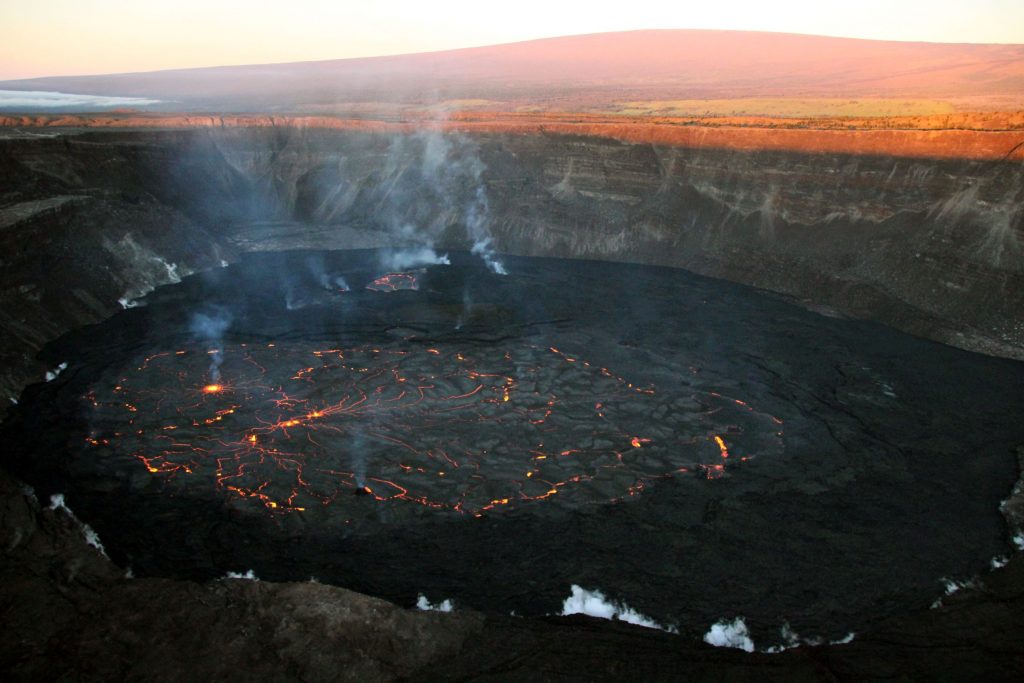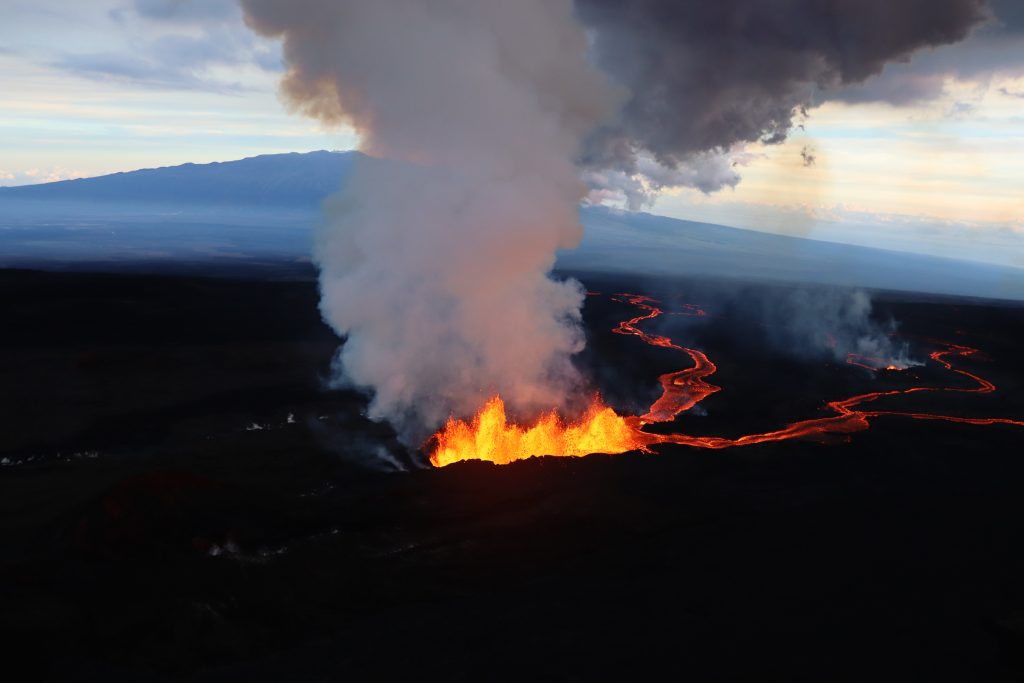Volcano Awareness Month keeps you in the know about Mauna Loa and Kīlauea

Usually, when Volcano Awareness Month on the Big Island takes place every January, it’s a reminder to people that they live alongside mountains that can erupt — and how they can be prepared.
The awareness events also inform new residents who might be learning about the dangers of the volcanoes for the first time.
But during the past few months, Mauna Loa and Kīlauea have showcased their power, spewing red- and orange-glowing lava that made everyone on Hawaiʻi Island take notice — as well as millions of people around the globe.
Mauna Loa awakened the night of Nov. 27, 2022, after a 38-year slumber. The flow from the main vent made it to less than 2 miles away from Daniel K. Inouye Highway, or Saddle Road, before its supply of lava ceased and the eruption paused on Dec. 10 .
At the same time about 18 miles away, the September 2021 eruption of Kīlauea continued filling a lava lake in Halema‘uma‘u crater. The last time the volcanoes erupted at the same time was in 1984, which also was the last time Mauna Loa erupted prior to last year.
That eruption ceased on Dec. 9, just a day before Mauna Loa’s eruption paused — but a new eruption began on Jan. 5 in a different location of Halema‘uma‘u, and it is still flowing.
“We have been busy,” said Hawaiian Volcano Observatory Scientist-in-Charge Ken Hon, who has become a familiar face on TV newscasts and observatory briefings.

Hon said the eruptions have been a good lead up to Volcano Awareness Month, which has been observed every January since 2010.
Throughout the month, the Hawaiian Volcano Observatory, in cooperation with Hawai‘i Volcanoes National Park, the Hawai‘i County Civil Defense and other partners, promotes the importance of understanding and respecting the volcanoes that people on the island call home.
This year is no different. Several community talks, guided walks and programs are planned during the 14th annual Volcano Awareness Month.
The first program will be hosted by geology professor Steve Lundblad at the University of Hawai‘i at Hilo. He will focus on tracking active faults and ground deformation south of the Kīlauea caldera. The talk begins at 7 p.m. in University Classroom Building Room 100 on the main UH-Hilo campus at 200 W. Kawili St. in Hilo.
Lundblad will describe how UH-Hilo geology students track ground movements in Kīlauea volcano’s Koa‘e fault system, which connects the volcano’s East and Southwest Rift Zones south of the caldera. The on-the-ground measurements complement Hawaiian Volcano Observatory geodetic instruments to keep track of this active part of Kīlauea.

At another event on Saturday, Hawaiian Volcano Observatory scientists and Hawaiʻi County public safety officials will return to Ocean View for another discussion about Mauna Loa.
The talk-story event will include informative displays and discussion with officials and scientists about the world’s largest active volcano, which takes up more than half of the Big Island’s surface area. The open house program is from 1 to 3 p.m. at the Ocean View Community Center at 92-8924 Leilani Circle in Ocean View.
Both events are free and open to the public; no reservations are required.
Additional events are planned through the end of the month. Details about all 2023 Volcano Awareness Month programs and events are available online. For more information, email [email protected].
Ocean View was the site of the first of several meetings last fall to encourage people to prepare for an eruption and answer questions after the 13,681-foot-tall Mauna Loa began a period of heightened unrest.
“We can’t necessarily forecast exactly when an eruption will happen, but like the Mauna Loa eruption, we were able to identify a period when it was much, much more likely that it would erupt and we were able to prepare the community,” Hon said.
He said the meetings and effort to raise awareness during the fall was a great exercise for everybody on the island, most importantly helping make sure residents who live on Mauna Loa’s slopes weren’t surprised when it did erupt.

“Remember: They live on the world’s biggest active volcano and it doesn’t give you much warning,” Hon said.
Compared to the 2018 eruption of Kīlauea, when it took about one to two weeks before seismicity really ramped up and lava found its way to the surface in the volcano’s lower East Rift Zone, the major spike in seismicity before Mauna Loa erupted in November lasted just 45 minutes before lava emerged.
Fortunately, the Nov. 27 eruption of Mauna Loa and subsequent lava flows, while one flow front did encroach on Saddle Road, were contained to the unpopulated Northeast Rift Zone. If lava would have flowed down the southwest slopes instead, a much steeper part of the mountain where communities such as Ocean View and Pāhala are located, people would have needed to act — and act fast. During Mauna Loa’s 1950 Southwest Rift Zone eruption, lava made it to the ocean within three hours.
So it was important that the Hawaiian Volcano Observatory and Hawai‘i County shared what they did know with the public after the heightened unrest began under the mountain.
“The community did a great job,” Hon said. “I think everybody really took the message to heart, so I think we’ve all learned important lessons from this. To me, that’s very satisfying that we were able to get messages out there.”
He said Hawaiian Volcano Observatory scientists will be visiting Big Island communities and talking with people during Volcano Awareness Month to see what they can do better.
Hon said the observatory always tries to promote certainty in uncertain times. While scientists might not yet be able to say exactly when an eruption will begin, where lava will flow and on what day, the agency always keeps the public informed about what it does know so people are aware of what’s happening.
Volcano Awareness Month furthers that mission of making sure the public is prepared for volcanic activity when and if it happens. Mauna Loa’s recent eruption is a good reminder for Big Island residents and visitors that emergency preparedness cannot be overemphasized; being aware of the hazards that can impact daily life is an important aspect.

After all, Kīlauea and Mauna Loa are just two of the six active Hawai‘i volcanoes the Hawaiian Volcano Observatory monitors. Kama‘ehuakanaloa, formerly Lō‘ihi Seamount, on the seafloor to the south of the Big Island erupted in 1996; Hualālai in West Hawai‘i erupted a couple of centuries ago; Haleakalā on Maui erupted several hundred years ago; and Maunakea, the tallest volcano in the islands, erupted several thousand years ago.
While eruptions can be spectacular to watch and experience, they provide a stark reminder of how life on the Big Island can be impacted very quickly by volcanic activity.
“Our volcanoes are still active and will erupt again, so volcano awareness should not be put on the backburner, so-to-speak,” the observatory said in its Dec. 15, 2022, edition of “Volcano Watch,” the weekly article and volcanic activity update written by the agency’s scientists and affiliates.

Hon said it’s important to know the risks and hazards of living on or near an active volcano, especially as communities on the island continue to grow.
“An ever increasing population means that you have an ever increasing risk or exposure, so the hazard may not change, but the risk and exposure can go up exponentially depending on how many people move into an area,” he said. “So it’s important that we get better and better at all this because we’re gonna have more and more people in these areas.”















